2024-11-6
Cathy Teng /photo by Jimmy Lin /tr. by Phil Newell
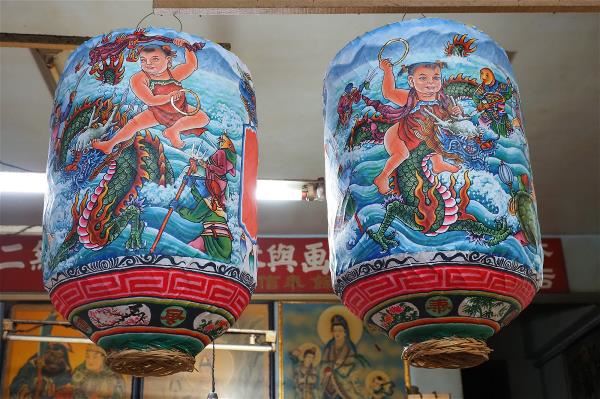
In the middle of the seventh month of the lunar calendar, we visit Chunqiu Fine Arts Studio on Minzu Road in Changhua City. The arcade space outside the studio is hung with numerous handmade lanterns of various designs. Depicted on them are personalities including the four great field marshals of Daoist legend, surnamed Wen, Kang, Ma, and Zhao, as well as the four deities in charge of wind, rain, thunder, and lightning. Each of the vivid figures, some astride horses or other beasts and others riding clouds, is like the painting of a master. Chunqiu founder Tang Qiushui says: “You’re very lucky to have come at this time. These lanterns were ordered by the Dajia Jenn Lann Temple in Taichung. This is the Year of the Dragon, and at the end of the year they will be holding a Daoist religious ritual, so the area will be buzzing with activity. This rite takes place only once every 36 years, so we made 36 lanterns for them, and the design on each is unique—things that you ordinarily don’t see.”
Lanterns were traditionally used to provide light. Long ago people used candles for light, and enclosed them in lanterns to protect the flame from the wind. Later, lanterns became canvases for creative work, greatly enhancing their artistic value. In modern times, electric lights have been invented and cheap plastic products have replaced traditional bamboo lanterns, yet one can still find exquisite handmade bamboo lanterns hanging in temples, embodying the glory this craft once enjoyed.
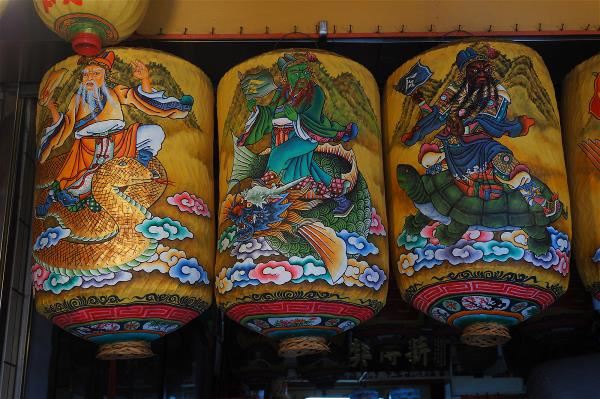
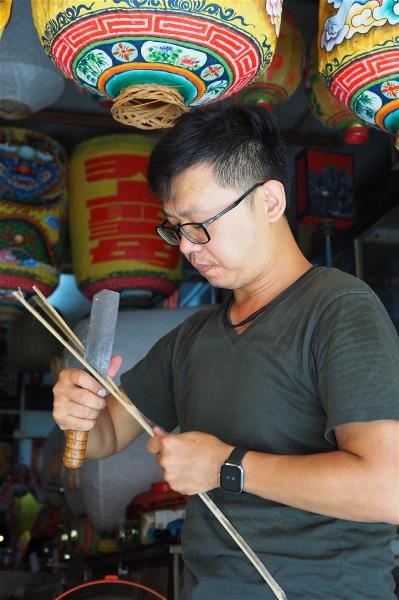
An ancient skill
For this story we went to Changhua in Central Taiwan. The old saying “First Tainan, second Lukang, third Bangka” indicates what were once the three most important and prosperous places in Taiwan, and even today many practitioners of old professions can still be found in the Lukang–Changhua area. However, for the craft of making bamboo lanterns, survival has not been easy. Still, says Tang Qiushui, thanks to Taiwan’s freedom of religion, each year there are many religious festivals and processions for which lanterns are still needed to lead the way. The lanterns used by performance troupes and in religious rituals are especially rich in symbolic content.
In the past, the construction of the lanterns themselves and their calligraphy and decoration were done by different artists. Tang Qiushui, who has shown great artistic talent since childhood, founded Chunqiu Fine Arts Studio with his father. For a time, his father handled the lantern making while he did the artwork on them. Tang Qiushui’s son Tang Jiaxing has been immersed in this field from a young age, and is a highly skilled painter and calligrapher. Ten or so years ago, he resigned his job as a teacher and returned to his hometown to enter the family business, only to learn that the skill of weaving lanterns had virtually died out. “In the past, bamboo was an important material, and women lantern makers were kept busy full time. But since the advent of plastic, bamboo has been displaced, and we’ve had to learn this skill ourselves, or we would have no lanterns to work on.”
Tang Jiaxing, who has learned enough to master the craft, recalls the scene when he was small of his grandfather making lanterns. Though his father vaguely knows the process, he has never completely mastered it. Besides figuring things out on his own, Tang Jiaxing also sought out an old master craftsman to teach him, and only then was he able to hone his bamboo weaving skills to the high level they have reached today.
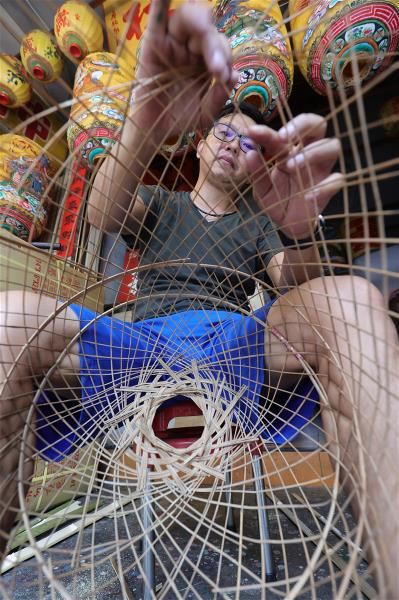
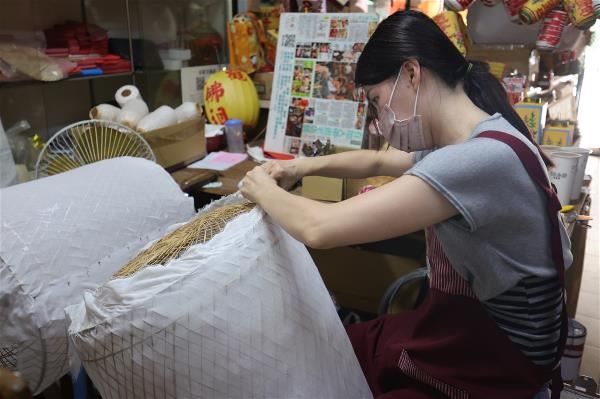
Birth of a lantern
“To make a lantern from bamboo strips, you start with a length of bamboo.” Under the arcade of his own home, Tang Jiaxing demonstrates how to cut bamboo, explaining the process as he goes. Taking a piece of three-year-old makino bamboo, he splits it lengthways into two pieces, then the two into four, the four into eight and so on, until he has strips of the width needed for the size of lantern he is making. He then removes the inside layer of the bamboo, leaving only the outer skin. “The outer skin is more flexible, but also more sturdy.”
Lanterns woven from bamboo strips require no nails or adhesives to hold them together. Tang picks up a half-finished example and says: “Weaving means repeatedly passing strips over and under each other as warp and weft, and woven objects are solid because of the way the warp and weft bite down on one another. That’s the basic idea, anyway.”
After the framework of a lantern is completed, the next step is to attach the cover, by stretching gauze fabric over the frame and applying a thin layer of starch paste. “The purpose is to seal the pores of the fabric, so that the lantern can be decorated with painting and calligraphy.” This marks the biggest difference with the sculptural lanterns made for Lantern Festival in Taiwan. “Lantern Festival lanterns are sculpted, but for our lanterns we do no modeling. We mainly rely on painting with colors and calligraphy for decorative effect,” says Tang with emphasis.
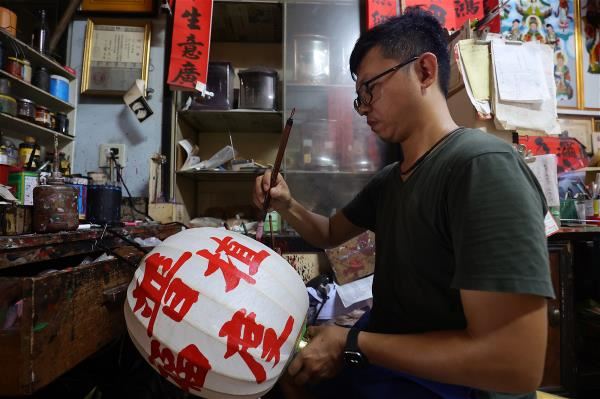
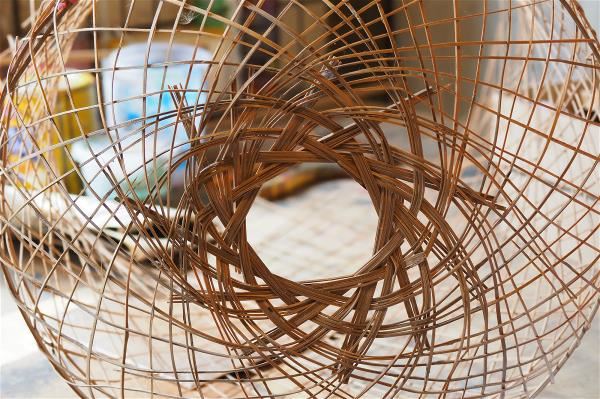
The height of artistic skill
“The images on lanterns are determined by the buyers. We make them to order to suit each customer,” says Tang. He is confident that he can paint anything that a customer can describe.
Lanterns made by the Tangs can be found all over Taiwan. Six hang in Longshan Temple in Taipei’s Wanhua District, each two meters in height, while Tamsui’s Longshan Temple has lanterns that depict the Bodhisattva Guanyin and the Four Heavenly Kings. At present the Tangs’ biggest lantern—the largest woven bamboo lantern in all Taiwan, at three meters tall—hangs in Yuhuang Temple in Changhua City. On it are painted the three-eyed deity Wangtianjun, who watches over all that happens under heaven, and Marshal Zhao, who wields an iron whip. Father and son also dream of creating a lantern that will be cited in Guinness World Records. But this is not merely for the sake of setting a new record—they also hope their lantern will become an important landmark in Taiwan, just as the 3.9-meter-tall lantern at the Kaminarimon Gate in Asakusa, Japan has done. It can be displayed at a major scenic location and showcase the craftsmanship of handmade bamboo lanterns for all to see.
When asked which of the lanterns he has painted he finds especially memorable, Tang Qiushui replies that once a customer ordered two ceiling lanterns on the theme of “Nezha Shaking the Seas” (a.k.a. “Nezha Conquers the Dragon King”). In the legend, Nezha, the Third Prince, wields his red armillary sash to whip up the ocean, creating huge waves and frightening the “shrimp soldiers and crab generals” of the Dragon King’s army. He also directly attacks the Dragon King’s palace. Tang vividly portrayed the image of Nezha, still a mischievous child at the time, wreaking havoc in the Eastern Sea, the home of the Dragon King. “This is a painting that tells a story, that has a plot.” After painting this lantern, Tang was honored in the folk arts and crafts category at the Global Chinese Culture and Arts Awards in 2018.
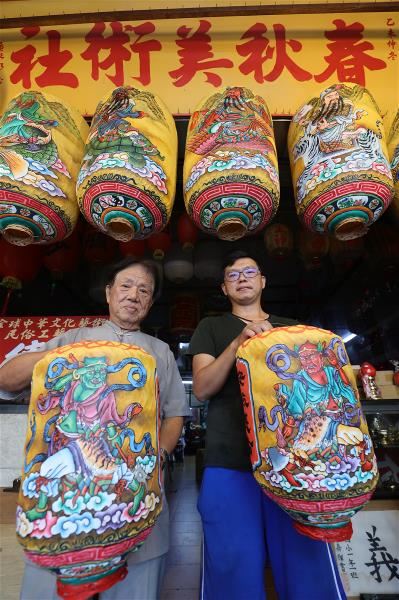
Lanterns’ many meanings
Lin Mao-hsien, associate professor in the Department of Taiwanese Languages and Literature at National Taichung University of Education, has studied the folk rituals of people all over Taiwan. He states: “The earliest purpose of lanterns was to provide light, but later, at the cultural level, they took on religious functions.” For example, when there is a procession or pilgrimage of a deity, there is always a “lead lantern” in front. Originally this was used to light the way, but eventually it came to symbolize “guiding,” with everyone following the lantern.
When temples hold their Pudu (“crossing over”) ceremonies during Ghost Month, they always erect poles with lanterns. “The purpose of hanging lanterns on bamboo poles is to guide lonely ghosts along their way.” Lin asks playfully how we can get in touch with these spirits, who have no email and are not on social media. “Wandering ghosts out on the road need lantern poles, while spirits in the water need floating lanterns, to tell them to come to the temple for the Pudu banquet.” In this case, lanterns are a means of communication, transmitting messages between humans and the spirit world.
Lin adds that in traditional villages, one can often see a whole line of lanterns hung out over the road. “This is a way of demarcating a ritual zone, indicating that the area is set aside for religious ceremonies.”
There is a traditional connection between lanterns and life itself. Lin says that in Romance of the Three Kingdoms, the statesman Zhuge Liang kept himself alive by keeping seven lamps burning. “If the lamps are alight, the person is alive; when the lamps go out, the person dies.”
Temples invariably also have doudeng lanterns, comprising a square wooden box with various symbolic objects inside, including an umbrella, sword, ruler, steelyard, and scissors. The box itself represents the “square Earth,” while the umbrella represents “round Heaven.” The “seven-star sword” represents the Big Dipper in the northern sky, while the ruler is used to measure length, specifically the long body of a dragon. This is a reference to the Azure Dragon of the East, one of the Chinese constellations that symbolize the guardians of the four cardinal directions. The gradations along the steelyard give it the appearance of a tiger’s tail, referencing the White Tiger of the West, while the scissors, when open, resemble the beak of a bird, representing the Vermilion Bird of the South. The scissors and steelyard are made of metal, and the base of the lamp is made of wood, while inside it are a candle, representing fire, and white rice, which grows out of the earth, thus accounting for four of the five Chinese elements—metal, wood, fire, earth, and water. “Thus you can see that a doudeng lantern is a conceptualization of the universe. Normally there is one for each community, representing the wellspring of its life force.”
Another custom is known as “lining up lanterns.” In this case, “many lanterns are arranged in a line, indicating that the community’s future is bright.” Lin adds: “In Changhua’s Huatan Township, for over a century they have been holding an event involving a ‘welcoming line of lanterns,’ symbolizing that the community is thriving. The same is done in Beigang during the Mazu Pilgrimage.”
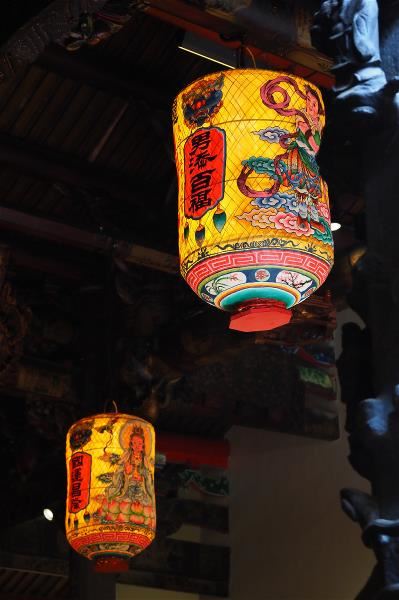
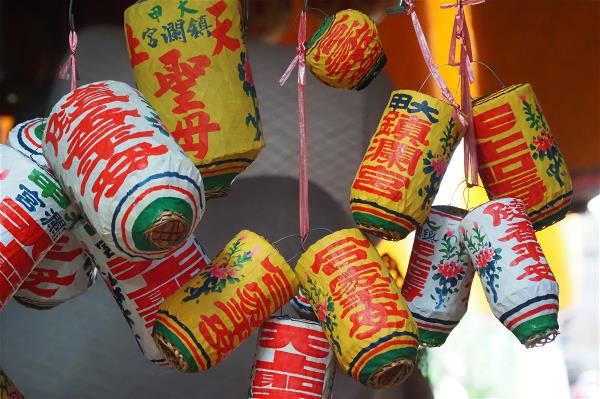
Lanterns: Symbols of male offspring
Lanterns are an indispensable element in the life rituals of ethnic Chinese, especially as we love to use wordplays on similar-sounding words to express wishes for good fortune. Lin explains that in the labor-intensive agricultural economy of days gone by there was high demand for manpower, and people wanted to have many children and grandchildren. In Taiwanese, the word for “lantern”—ting—is pronounced the same as the word for “male person,” giving rise to a play on words between “lantern” and “adding male children.” One of the 12 gifts traditionally given at engagement ceremonies was a “lantern wick,” expressing hope for the rapid birth of male children. If the bride did not quickly become pregnant after her marriage, her family would place a lantern in her room on Lantern Festival, with “giving a lamp” sounding the same as “giving a son.”
Lin further explains that during funeral rituals the bereaved family will hang a lantern bearing the clan’s surname at the door of their home, expressing the hope that the clan will produce numerous male offspring. Tang Qiushui also tells us of an ancient tradition in Lukang whereby a funeral procession would be led by a white lantern, which would be burned on a hilltop after the burial, and two red lanterns would be used for the return journey. This is what local people called “white going out, red coming back.” Although this custom is rarely observed today, it is still remembered as a special feature of local culture.
Looking at nearby countries, in northeastern Japan they have the Nebuta Festival in Aomori Prefecture, which now features illuminated floats but started with lanterns, as well as the Kanto Festival in Akita Prefecture, celebrated with numerous large lanterns held aloft on poles. Meanwhile in Southeast Asia people observe floating lantern festivals. “Lamps and fire represent brightness and light in countless cultures, and fire itself has the meaning of ‘cleansing,’ in the sense of burning away all bad things,” concludes Lin Mao-hsien. From a single lantern we can see the art and emotional attachments of a culture.
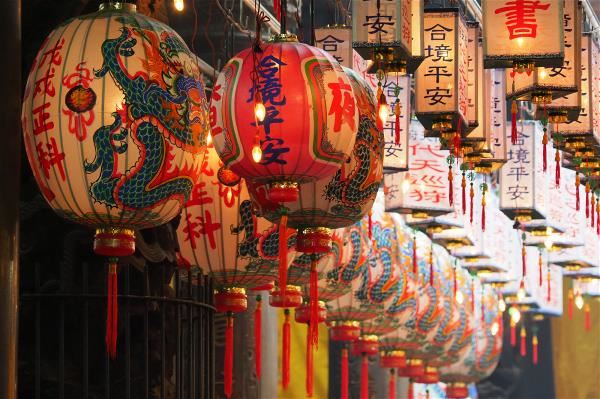
Article and photos courtesy of Taiwan Panorama October 2024




